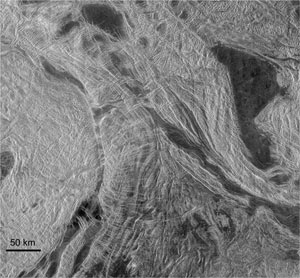NASA Grant to Fund Study on Venus’s Landscape

Thanks to NASA, two Earth and Environmental Science faculty are going to spend the better part of their next three summers on Venus looking at volcanoes and mountain ranges.
Specifically, Martha Gilmore, associate professor of earth and environment science, and Phillip Resor, assistant professor of earth and environmental science, will be using a three-year NASA grant to examine an area of Venus called the Tellus Regio, which is contains some of the oldest rocks on the planet’s surface.
“It’s an area of interest for two reasons, primarily,” says Gilmore, who has done work on Mars and Venus missions, among others for NASA’s Jet Propulsion Laboratory (JPL). “First, it’s an area that is high on NASA’s list of potential landing spots for an upcoming mission. It’s also an area that experienced a lot of tectonic activity in the past, but in a way that’s not like what we’ve seen here on Earth so it’s very interesting.”
Interesting because, of all the planets in the solar system, Venus appears to be most like Earth in many ways. However, radar data and other imagery generated by NASA’s Magellan probe , which orbited the planet from 1990-1994 on a mapping mission show some significant differences that have many scientists who study geology and plate tectonics very curious.
Some of the data generated by Magellan indicate that, about 500 million years ago, Venus was very active. Numerous volcanoes and lava flows erupted on the planet’s surface and leaving about 80 percent of the landscape covered in basaltic lava. Tellus Regio, a plateau not far from the planet’s equator, seems to predate and have survived this volcanic outpouring. However, data also suggest unlike on Earth, none of the phenomena observed had been caused by the collision or subduction of tectonic plates. In fact, there don’t appear to be any moving tectonic plates on Venus at all.

One of Gilmore’s students, Beck Straley ’07 became extremely intrigued and used some of the data as a subject for a senior thesis. In it, Straley examined the radar data to show that the mountainous Tellus Regio was actually created by crust in collision.
“Despite the absence of subducting plate, the crust collides creating a buckling effect,” Gilmore says. “Imagine it like a buckling in a carpet causing ridges in the rug. It’s basically the same effect only on a much larger scale.”
Gilmore was able to use the information generated by Staley’s thesis along with her own research to interest NASA into giving her and Resor more than $200,000 to study the area during the next three summers. The grant was the result of a $6,000 NASA CT seed grant Gilmore received a year ago, which Wesleyan matched.
“We are applying buckle fold theory, which relates the wavelength of folds on the surface of Venus to the thickness and stiffness of the folding layer, Resor says. “Thickness and stiffness are in turn a function of thermal gradient, crustal thickness and composition, and strain rate. We can thus use temporal and spatial changes in fold wavelength as a tool to explore the thermal and compositional evolution of Venus’ outer layers.
Gilmore will be doing the lion’s share of mapping and measuring of wavelengths and Resor will handle most of the modeling to show what happened. It presents several challenges, not the least of which is that there will be no opportunity to take on-site measurements or observations.
Despite all the satellite data, there are still significant challenges associated with the study.
“Many of the model parameters are not very well known,” Resor says. “Even the composition of the terrain is debated by some. Since we can’t observe the structures we are modeling directly we have to infer the sense of motion based on analogous structures on Earth.”
They also don’t have the advantage of having currently active areas on Venus that they can compare in hopes of better understanding what the deformation rates were half a billion years ago. On the positive side the crust and mantle appear to be very similar to what’s seen on ocean floors here on Earth.
“There’s not a firm understanding of how Venus recycles its crust,” Gilmore says. “This study could help improve that situation.”
Specifically, Gilmore says that the study will be able to offer some significant information about the heat-flow on Venus at the time of the eruptions and project it to what is happening now.
“Half a billion years is not a long span in geological time so this is a very brief view,” she says. “Still, this plateau is an area of special interest for NASA. That we’ll be helping them gather information to perhaps build a case to land a spacecraft at this site is very exciting. And certainly, this type of study could open the door to more extensive inquiry.”

